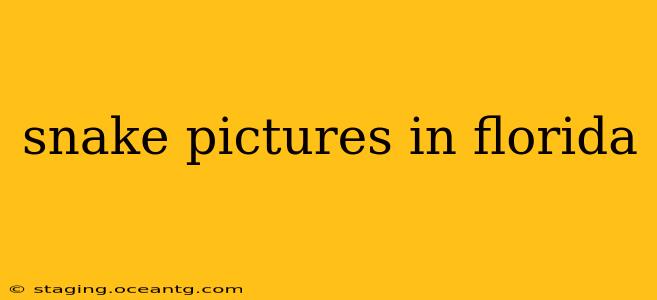Florida boasts a rich biodiversity, and its snake population is no exception. From the venomous coral snake to the non-venomous black racer, a wide variety of snakes call the Sunshine State home. This guide will help you identify some common Florida snakes through pictures and descriptions, addressing common questions about Florida snakes. Remember, responsible viewing is key – admire these creatures from a safe distance and never attempt to handle a snake unless you are a trained professional.
What are the most common snakes in Florida?
Florida's diverse habitats support a wide array of snake species. Some of the most frequently encountered include:
- Eastern Diamondback Rattlesnake: This is Florida's largest venomous snake, easily recognizable by its diamond-shaped patterns and rattling tail. Pictures often highlight its striking coloration and large size.
- Eastern Coral Snake: This highly venomous snake is known for its distinctive red, yellow, and black bands. Remember the rhyme: "Red on yellow, kill a fellow; red on black, venom lack." However, it's crucial to remember that this rhyme is not always accurate, and positive identification should be left to experts.
- Copperhead: A pit viper with a copper-colored head and hourglass-shaped markings along its body. Pictures will typically show its characteristic pattern.
- Cottonmouth (Water Moccasin): Another pit viper, the cottonmouth is known for its dark body and the white interior of its mouth, which it displays when threatened.
- Black Racer: A fast, non-venomous snake with a completely black or dark-brown body.
- Corn Snake: Often kept as pets, these snakes are also found in the wild in Florida and are non-venomous, featuring a variety of colors and patterns.
- Rat Snake: Several species of rat snakes reside in Florida. These are non-venomous and known for their ability to climb and hunt rodents.
What are the venomous snakes in Florida?
Florida has several venomous snakes. It's critical to be able to identify these snakes to avoid potential bites. The most dangerous include the Eastern Diamondback Rattlesnake, Eastern Coral Snake, Copperhead, and Cottonmouth. If bitten by a venomous snake, seek immediate medical attention.
How can I identify snakes in Florida using pictures?
Identifying snakes solely from pictures can be challenging, even for experts. Several apps and online resources can help, but they shouldn't replace professional identification. Pay close attention to:
- Color and pattern: Note the specific colors and patterns on the snake's body, including the head and tail.
- Shape and size: Observe the snake's overall body shape and size.
- Head shape: The shape of the head can often indicate whether the snake is venomous. Pit vipers, for example, have triangular heads.
- Habitat: The location where you saw the snake can provide valuable clues to its species.
Disclaimer: Use caution when attempting to identify snakes from images. Misidentification can lead to dangerous situations. If you are uncertain about a snake's identity, assume it is venomous and maintain a safe distance.
Where can I find more snake pictures?
Many websites and books feature pictures and descriptions of Florida snakes. Search for reputable sources such as university herpetology departments or state wildlife agencies. Remember to critically evaluate any resource you use to ensure its accuracy. Look for sources that cite reputable scientific studies.
Are there any apps that help identify snakes?
Yes, several apps are designed to aid in snake identification. However, remember that these apps are not foolproof. Always use caution and maintain a safe distance from any snake you encounter. Professional identification should be sought if a definitive ID is needed for any reason.
What should I do if I see a snake in Florida?
Most snakes in Florida are harmless and beneficial to the ecosystem. If you encounter a snake, give it space and allow it to move away on its own. Do not attempt to handle or kill it. If the snake appears to be venomous or you feel threatened, contact your local wildlife authorities for assistance. Remember, responsible observation and a respectful distance ensure both your safety and the snake's well-being.
